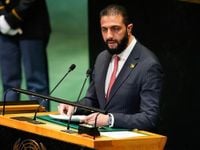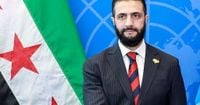History is in the making this week in Washington, as Ahmad al-Sharaa, Syria’s new president and a former militant once imprisoned by U.S. forces, becomes the first Syrian leader to visit the White House since the country’s independence in 1946. The visit, set for Monday, November 10, 2025, marks a dramatic reversal in U.S.-Syrian relations and signals a possible turning point for a nation battered by 13 years of civil war and decades of diplomatic isolation.
Al-Sharaa’s journey to the White House is nothing short of extraordinary. Two decades ago, he was detained in a U.S.-run facility in Iraq after joining al-Qaida militants fighting American troops. Later, he led Hayat Tahrir al-Sham (HTS), an offshoot of al-Qaida that eventually broke away from the network and became a rival of the Islamic State (IS). Under the alias Abu Mohammed al-Golani, al-Sharaa was subject to a $10 million U.S. bounty and was designated a global terrorist. But in a stunning reversal, his rebel forces ousted longtime Syrian ruler Bashar al-Assad in December 2024, catapulting him from insurgent commander to head of state.
Since assuming power, al-Sharaa has launched a vigorous campaign to restore Syria’s standing on the global stage. According to BBC, he addressed the United Nations General Assembly in September 2025, declaring that Syria was “reclaiming its rightful place among the nations of the world” and urging the international community to lift sanctions that had crippled the country’s economy. The World Bank estimates that Syria’s reconstruction will cost at least $216 billion—a conservative figure for a nation devastated by years of violence.
Al-Sharaa’s push for international legitimacy has gained traction. On Thursday, November 6, the U.N. Security Council voted to lift sanctions against him and his interior minister, Anas Hasan Khattab. The following day, the U.S. Treasury Department formally removed both men from its list of individuals suspected of supporting extremist groups, citing “the progress demonstrated by the Syrian leadership.” State Department spokesman Tommy Pigott told reporters, “These actions are being taken in recognition of the progress demonstrated by the Syrian leadership after the departure of Bashar al-Assad and more than 50 years of repression under the Assad regime.”
Washington’s shift in policy was already apparent in May 2025, when President Donald Trump met al-Sharaa for the first time in Riyadh. There, Trump announced his intention to lift decades-old sanctions and described al-Sharaa as “a tough guy, very strong past.” Now, as al-Sharaa arrives in Washington, the two leaders are expected to finalize Syria’s entry into the U.S.-led coalition against the Islamic State group. U.S. envoy Tom Barrack told Reuters that Syria will “hopefully” sign an agreement to join the coalition during this visit—a move seen as a “milestone” in the fight against IS, which, despite losing its territorial hold, continues to launch deadly attacks in both Syria and Iraq.
Coinciding with al-Sharaa’s arrival, Syria’s Ministry of Interior launched a large-scale security operation targeting IS cells across the country. According to the Syrian state news agency SANA, security forces conducted 61 raids in Aleppo, Idlib, Hama, Homs, and the Damascus countryside, arresting at least 71 suspects and seizing explosives and weapons. A ministry spokesperson stated that these operations were part of “ongoing national efforts to combat terrorism and protect public safety.” Lt. Cmdr. Emily Pumphrey, a spokesperson for U.S. Central Command, reported that there have been 311 IS attacks in Syria and 64 in Iraq so far in 2025, a significant drop from the previous year’s figures.
Yet, the path to peace and stability is far from smooth. Sectarian tensions have flared in recent months, with pro-government Sunni gunmen implicated in the deaths of hundreds of Alawite and Druze civilians. Al-Sharaa has publicly promised to hold perpetrators accountable, but minority communities remain wary. The advocacy group Save the Persecuted Christians sent a letter signed by over 100 U.S. religious leaders urging President Trump to address the “massacre” of minorities and to push for a humanitarian corridor from the Israeli-controlled Golan Heights to the Druze enclave of Sweida in southern Syria.
Meanwhile, the political debate in Washington over Syria’s future is heating up. One key issue is the fate of the Caesar Act, a set of sweeping sanctions imposed over human rights abuses by Assad’s government. The sanctions are currently waived by presidential order, but a permanent repeal requires congressional approval. While the Senate has advanced a repeal as part of the annual defense authorization bill, some top Republicans in the House want to attach conditions, such as ensuring protection for religious and ethnic minorities, maintaining peaceful relations with regional neighbors—including Israel—and removing foreign fighters from Syrian government institutions.
Sen. Jeanne Shaheen, the top Democrat on the Senate Foreign Relations Committee, has championed a full repeal of the Caesar Act, arguing, “We have a real opportunity in the Middle East right now that we haven’t had in my lifetime.” Advocates for lifting the sanctions contend that it is unfair to keep punitive measures designed for the Assad regime in place against new authorities, and that the threat of a “snapback” provision would deter international investment in Syria’s reconstruction. Mouaz Moustafa, executive director of the Syrian Emergency Task Force, told Associated Press, “But to use Caesar for that is like using a sledgehammer instead of a scalpel—you’re going to kill the person you’re operating on.”
Internationally, Syria’s new government is also navigating complex regional dynamics. Since Assad’s fall, Israel has seized a formerly U.N.-patrolled buffer zone in southern Syria and is negotiating a potential security agreement with Damascus. Reports from AFP and Reuters suggest that Washington is preparing to establish a military presence at an airbase in Damascus to support a U.S.-brokered security pact between Syria and Israel, though Syrian officials have denied these claims.
Domestically, al-Sharaa faces the monumental task of rebuilding a fractured nation. In a recent interview with “60 Minutes,” he acknowledged the deep scars left by the war, saying, “There are entire generations of Syrians that have suffered tremendous psychological trauma under the Assad regime.” His government has also taken steps to meet U.S. demands, including efforts to locate missing Americans and eliminate any remaining chemical weapons stockpiles.
One of the most ambitious proposals on the table is to merge the Kurdish-led Syrian Democratic Forces (SDF) with the new Syrian army. While both sides have agreed in principle, implementation has been hampered by ongoing tensions and sporadic clashes. The U.S. military has expanded its cooperation with Damascus since al-Sharaa took power, but the process of unifying rival armed factions remains fraught.
As al-Sharaa’s convoy rolls through Washington, the world watches closely. Will this visit truly mark a new era for Syria, or will old divisions and suspicions prove too deep to overcome? For now, the meeting between al-Sharaa and Trump stands as a symbol of both the challenges and the possibilities that lie ahead for a country long at the crossroads of history.


